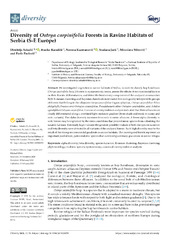Приказ основних података о документу
Diversity of Ostrya carpinifolia Forests in Ravine Habitats of Serbia (S-E Europe)
| dc.creator | Sekulić, Dimitrije | |
| dc.creator | Karadžić, Branko | |
| dc.creator | Kuzmanović, Nevena | |
| dc.creator | Jarić, Snežana | |
| dc.creator | Mitrović, Miroslava | |
| dc.creator | Pavlović, Pavle | |
| dc.date.accessioned | 2021-03-12T10:27:41Z | |
| dc.date.available | 2021-03-12T10:27:41Z | |
| dc.date.issued | 2021 | |
| dc.identifier.issn | 1424-2818 | |
| dc.identifier.uri | https://www.mdpi.com/1424-2818/13/2/59 | |
| dc.identifier.uri | https://radar.ibiss.bg.ac.rs/handle/123456789/4159 | |
| dc.description.abstract | We investigated vegetation in ravine habitats of Serbia, in order to classify hop hornbeam (Ostrya carpinifolia Scop.) forests in syntaxonomic terms, assess the effects of environmental factors on their floristic differentiation, and detect the biodiversity components of the analyzed communities. Both K-means clustering and Bayesian classification revealed five ecologically interpretable groups of forests that belong to the alliances Ostryo carpinifoliae-Fagion sylvaticae, Ostryo carpinifoliae-Tilion platyphylli, Fraxino orni-Ostryion carpinifoliae, Pseudofumario albae-Ostryion carpinifoliae, and Achilleo ageratifoliae-Ostryion carpinifoliae. Canonical correspondence analysis indicated that these alliances are clearly differentiated along a combined light–moisture gradient (from shade and mesic to sunny and xeric variants). The alpha diversity increases from xeric to mesic alliances. A lower alpha diversity in xeric forests may be explained by the stress conditions that prevent mesic species from colonizing the saxatile habitats. Extremely high—almost the greatest possible—values of both the species turnover and beta diversity were detected in all variants of the analyzed forests. Such high diversity may be the result of the strong environmental gradients in ravine habitats. The investigated forests represent an important pool of rare, paleo-endemic species that survived Quaternary glaciations in ravine refugia. | |
| dc.publisher | MDPI AG | |
| dc.relation | info:eu-repo/grantAgreement/MESTD/inst-2020/200007/RS// | |
| dc.rights | openAccess | |
| dc.rights.uri | https://creativecommons.org/licenses/by/4.0/ | |
| dc.source | Diversity | |
| dc.title | Diversity of Ostrya carpinifolia Forests in Ravine Habitats of Serbia (S-E Europe) | |
| dc.type | article | en |
| dc.rights.license | BY | |
| dcterms.abstract | Секулић, Димитрије; Кузмановић, Невена; Павловић, Павле; Караджић, Бранко; Јарић, Снежана; Митровић, Мирослава; | |
| dc.rights.holder | © 2021 by the authors. Licensee MDPI, Basel, Switzerland. | |
| dc.citation.issue | 2 | |
| dc.citation.volume | 13 | |
| dc.identifier.doi | 10.3390/d13020059 | |
| dc.identifier.scopus | 2-s2.0-85100969240 | |
| dc.identifier.wos | 000622468900001 | |
| dc.citation.apa | Sekulić, D., Karadžić, B., Kuzmanović, N., Jarić, S., Mitrović, M., & Pavlović, P. (2021). Diversity of Ostrya carpinifolia Forests in Ravine Habitats of Serbia (S-E Europe). Diversity, 13(2), 59. | |
| dc.citation.vancouver | Sekulić D, Karadžić B, Kuzmanović N, Jarić S, Mitrović M, Pavlović P. Diversity of Ostrya carpinifolia Forests in Ravine Habitats of Serbia (S-E Europe). Diversity. 2021;13(2):59. | |
| dc.citation.spage | 59 | |
| dc.type.version | publishedVersion | |
| dc.identifier.fulltext | https://radar.ibiss.bg.ac.rs/bitstream/id/8259/diversity-13-00059-v4.pdf | |
| dc.citation.rank | M22 |

